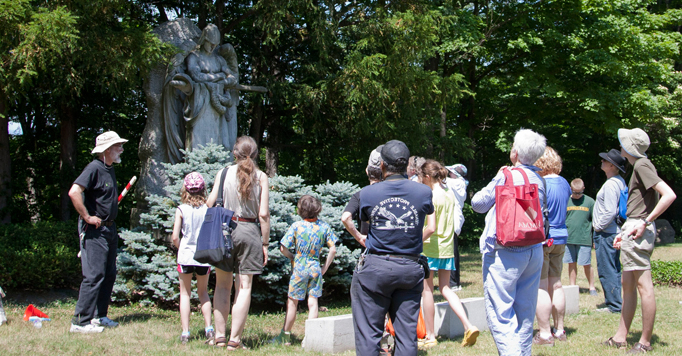Cultural Geology Field Trips & Walking Tours
The
Department of Invertebrate Paleontology conducts field trips and walking tours that explore aspects of cultural geology — that is, the relationship of geology to human culture. Examples include the use of stone for building material, and the relationship between natural and constructed environments. Rocks, fossils and minerals, along with the geologic setting of the locale, are always part of these programs.
There are usually five trips per year, and they run rain or shine. No geological background is necessary.

Urban Rocks - Near West Side/Ohio City Stones
This van trip visits a number of iconic Cleveland buildings and bridges in Ohio City and the Flats, telling the story of the stones used in their construction. Included are the Old Viaduct, St. John’s Episcopal Church, St. Patrick’s Church and the Lorain-Carnegie Bridge — where participants get up-close-and-personal with the Guardians of Transportation and experience a panoramic view of the Flats and downtown skyline. Usually held in spring.
For insight about the stone used for local houses of worship, including those on this trip, read
Guide to Stones Used for Houses of Worship in Northeastern Ohio and
Guide to Stones Used for Houses of Worship in Northeastern Ohio.
Registration for this tour is open on a seasonal basis.
Cleveland Buildings and Their Stones
On this walking tour, look for minerals and fossils in the rocks of Cleveland’s best-loved buildings in and around Public Square, including the Cuyahoga County Soldiers’ and Sailors’ Monument. These buildings are made with or contain a great variety of stone including Berea Sandstone from Ohio; limestone from Indiana and Italy; marble from Georgia; and granite from Texas and South Dakota. This tour provides an introduction to these stones and their mineral and fossil components, and explains the geologic setting of downtown Cleveland. Usually held in the fall.
To take a self-guided version of this trip,
download a short guide for free; or
purchase a detailed guidebook from the Ohio Division of Geological Survey.
Registration for this tour is open on a seasonal basis.
Mermaids, Marble, Milling & More: Cultural Geology of University Circle
See University Circle through the eyes of a geologist. This walking trip examines familiar and unfamiliar features of the Circle. These include Doan Brook, Wade Lagoon and the iconic mermaids sculptures along its edge, the exterior of the Cleveland Museum of Art and the stone sculptures outside of it, Amasa Stone Chapel; and Adelbert Hall. Emphasis, of course, is on the geological aspects of these features. Usually held in the fall.
Registration for this tour is open on a seasonal basis.

LVC Rocks! Lake View Cemetery Geology Walking Trips
Lake View Cemetery contains a wealth of geologic features. The Museum offers two different walking tours of the cemetery.
LVC Rocks! Lake View Cemetery Geology Walking Trip, North
This walking trip examines stone used for Wade Chapel and the graves of two prominent Cleveland geologists—paleontologist John Newberry and geologist and archaeologist Charles Whittlesey—who are buried near features that they studied in life. It also discusses the stone for the Elliott Ness and other monuments, and visits the large dam in the center of the cemetery. Usually held in the fall.
LVC Rocks! Lake View Cemetery Geology Walking Trip, South
This trip visits the Garfield Monument, discussing the stone and setting of the monument, and the President who taught geology at 5am in the chapel of Western Reserve Eclectic Institute (now Hiram College).
Stones used for other monuments and headstones in the cemetery’s southern portion are discussed as they occur in a variety of settings. Conditions permitting, a visit is made to the old Euclid bluestone quarry area. This is the world’s longest-running regularly scheduled field trip in a cemetery. Usually held in the spring.
Registration for these tours is open on a seasonal basis.
For a description of these tours as they were given in the 1990s and early 2000s, download
Teaching With Tombstones. For a discussion of stone types in northeastern Ohio cemeteries, read
Distribution in Time, Provenance, and Weathering of Gravestones in Three Northeastern Ohio Cemeteries in the
Ohio Journal of Science. For information on Garfield and geology, as well as the man in the urn in the monument, read
The man in the urn: the geological contributions of Joseph Stanley-Brown, geologist, financier, and presidential aide in the journal
Earth Science History.